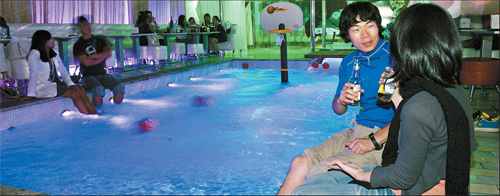Shabby chic, northern style - Suddenly, the other side of the river is getting trendy

The Spot, a club south of the river with a swimming pool inside. By Ahn Yoon-soo. 실내에 풀장이 있는 강남의 클럽 ‘더 스팟’ 사진=안윤수 기자
-urbane : 도시적인, 세련된
비평가들은 그것을 ‘강북’의 재발견이라고 부른다. 오랫동안 서울 북부 지역을 지칭하는 ‘강북’의 이미지는 도시적 감각과 유행의 첨단을 걷는 ‘강남’에 비해 많이 뒤떨어진 경직되고 구식인 것으로 여겨져 왔다.
While the south side has the image of being home to people with new money, fancy education and lots of access to Western culture, the north side is more known for wealth built through the generations, a place where traditions and familial values are important.
-fancy : <형용사> 공들인, 화려한, 일류의
강남은 새로운 부유층이 모이는 곳이며 훌륭한 교육환경과 서구 문명에 대한 접근이 쉬운 곳이라는 이미지가 강한 반면, 강북의 경우 여러 세대에 걸쳐 부를 이룬 사람들이 사라는 것으로 전통과 가족적 가치가 중시되는 곳으로 여겨졌다.
Those perceptions are changing, according to industry experts, as an increasing number of young Koreans see the North’s grafting of tradition and modernity as being uniquely stylish and cool.
전문가들은 최근 이런 인식들이 변화하고 있다고 주장한다. 점점 더 많은 한국 젊은이들이 전통과 현대성을 접목한 강북의 문화를 독특하고 멋진 것으로 느끼고 있기 때문이다.
“You have to wonder why more and more young Koreans these days upload pictures on their blogs of their excursions to hanok cafes in the north, eating waffles under a giwa roof, instead of photos of them drinking coffee at posh modern cafes in Gangnam,” says Beck Una, the chief editor of Magazine T, Internet publication for drama and pop culture for young Koreans.
-excursion : 여행, 소풍, 탐방
-posh : 호화로운, 우아한 ; (경멸적 의미로) 상류 계급의
젊은 세대를 대상으로 드라마와 대중문화를 다루는 인터넷 매체인 ‘매거진 T’의 백은아 편집장은 “우아하고 현대적인 강남의 카페에서 커피를 마시는 사진 대신, 강북의 한옥 카페를 찾아 기와 지붕 아래에서 와플을 먹는 사진을 자신의 블로그에 올리는 젊은 세대가 점점 늘어나는 현상에 주목해야 한다”고 말했다.
“That’s a major shift compared to the past, when popular TV Korean dramas were always set in the south. I wouldn’t call it nationalism, but the younger generation has come to realize that it’s more precious when Korean traditions meet outside cultures as opposed to simply mimicking Western trends. In a way, young Koreans today are more confident embracing their traditions than their parents’ generation.”
-mimic : 모방하다, 흉내내다.
백씨는 “인기 있는 TV 드라마가 늘 강남 지역을 무대로 하던 과거와 비교하면 이는 커다란 변화다. ‘민족주의’라고 부르기는 어렵겠지만 젊은 세대들이 단순히 서구의 유행을 흉내낸 것보다 한국 전통이 외래문화와 만날 때 더 가치가 있다는 것을 깨닫고 있다. 달리 보면 젊은이들은 부모 세대에 비해 전통 문화에 대해 더 큰 확신을 가지고 있다”고 말했다.
Hongdae people say they see dingy eateries, cheap drinks and grungy outfits as hip and arty, because they inherit the edgy spirit and underground culture that was once nourished by artists and musicians who were the area’s first settlers. They also believe that Hongdae culture is confident enough to ignore competitions over brands and class.
-dingy : 우중충한, 초라한, 평이 나쁜
-grungy : 넝마 같은
-edgy : 날카로운, 선명한; <구어> 신랄한; 유례없는, 혁신적인, 전위적인
(대표적인 강북지역인) 홍대 앞 사람들은 초라한 먹거리와 값싼 음료수, 넝마 같은 옷차림을 세련되고 예술적인 것이라고 여기는데 이런 것들이 이 지역을 처음 개척한 예술가와 음악가들이 남긴 전위적인 정신과 문화를 계승하고 있다고 보기 때문이다. 그들은 또 이와 같은 홍대 앞 문화가 브랜드와 계급 사이의 경쟁을 무시할 만큼 확고하다고 믿는다.










with the Korea JoongAng Daily
To write comments, please log in to one of the accounts.
Standards Board Policy (0/250자)